MEDICATION GUIDE
Dispense with Medication Guide available at: www.tevausa.com/medguides
Medication Guide
|
Oral Transmucosal Fentanyl Citrate (OTFC) (fentanyl citrate) oral transmucosal lozenge, CII IMPORTANT: Do not use Oral Transmucosal Fentanyl Citrate (OTFC) unless you are regularly using another opioid pain medicine around-the-clock for at least one week or longer for your cancer pain and your body is used to these medicines (this means that you are opioid tolerant). You can ask your healthcare provider if you are opioid tolerant. Keep OTFC in a safe place away from children. Get emergency medical help right away if:
These are medical emergencies that can cause death. If possible, remove OTFC from the mouth. |
Oral Transmucosal Fentanyl Citrate (OTFC) is:
- A strong prescription pain medicine that contains an opioid (narcotic) that is used to manage breakthrough pain in adults (16 years of age and older) with cancer who are already routinely taking other opioid pain medicines around-the-clock for cancer pain. OTFC is started only after you have been taking other opioid pain medicines and your body has become used to them (you are opioid tolerant). Do not use OTFC if you are not opioid tolerant.
- An opioid pain medicine that can put you at risk for overdose and death. Even if you take your dose correctly as prescribed you are at risk for opioid addiction, abuse, and misuse that can lead to death.
Important information about Oral Transmucosal Fentanyl Citrate (OTFC):
- Get emergency help or call 911 right away if you take too much OTFC (overdose). When you first start taking OTFC, when your dose is changed, or if you take too much (overdose), serious or life-threatening breathing problems that can lead to death may occur. Talk to your healthcare provider about naloxone, a medicine for the emergency treatment of an opioid overdose.
- Taking OTFC with other medicines that may make you sleepy, such as other pain medicines, anti-depressants, sleeping pills, anti-anxiety medicines, antihistamines, or tranquilizers, or with alcohol or street drugs can cause severe drowsiness, confusion, breathing problems, coma, and death.
- Never give anyone else your OTFC. They could die from taking it. Selling or giving away OTFC is against the law.
- Store OTFC securely, out of sight and reach of children, and in a location not accessible by others, including visitors to the home.
- If you stop taking your around-the-clock opioid pain medicine for your cancer pain, you must stop using OTFC. You may no longer be opioid tolerant. Talk to your healthcare provider about how to treat your pain.
- OTFC is available only through a program called the Transmucosal Immediate Release Fentanyl (TIRF) Risk Evaluation and Mitigation Strategy (REMS). To receive OTFC, you must:
- talk to your healthcare provider
- understand the benefits and risks of OTFC
- agree to all of the instructions
- sign the Patient Enrollment Form
- OTFC is only available at pharmacies that are part of the TIRF REMS. Your healthcare provider can help you locate a pharmacy closest to your home where you can have your OTFC prescription filled.
- Know the medicines you take. Keep a list of them to show your healthcare provider and pharmacist when you get a new medicine.
Do not take Oral Transmucosal Fentanyl Citrate (OTFC) if:
- You are not opioid tolerant. Opioid tolerant means that you are already taking other opioid pain medicines around-the-clock for at least one week or longer for your cancer pain, and your body is used to these medicines.
- You have severe asthma, trouble breathing, or other lung problems.
- You have a bowel blockage or have narrowing of the stomach or intestines.
- You are allergic to any of the ingredients in OTFC. See the end of this Medication Guide for a complete list of ingredients in OTFC.
- You have short-term pain that you would expect to go away in a few days, such as:
- pain after surgery
- headache or migraine
- dental pain
Before taking Oral Transmucosal Fentanyl Citrate (OTFC), tell your healthcare provider if you have a history of:
- troubled breathing or lung problems such as asthma, wheezing, or shortness of breath
- head injury, seizures
- slow heart rate or other heart problems
- low blood pressure
- mental problems [including major depression, schizophrenia or hallucinations (seeing or hearing things that are not there)]
- problems urinating
- liver, kidney, thyroid problems
- pancreas or gallbladder problems
- abuse of street or prescription drugs, alcohol addiction, opioid overdose, or mental health problems
- diabetes. Each OTFC unit contains about 1/2 teaspoon (2 grams) of sugar.
Tell your healthcare provider if you are:
- noticing your pain getting worse. If your pain gets worse after you take OTFC, do not take more OTFC without first talking to your healthcare provider. Talk to your healthcare provider if the pain you have increases, if your feel more sensitive to pain, or if you have new pain after taking OTFC.
- pregnant or planning to become pregnant. Use of OTFC for an extended period of time during pregnancy can cause withdrawal symptoms in your newborn baby that could be life-threatening if not recognized and treated.
- breastfeeding. OTFC passes into breast milk and may harm your baby. Carefully observe infants for increased sleepiness (more than usual), breathing difficulties, or limpness. Seek immediate medical care if you notice these signs.
- living in a household where there are small children or someone who has abused street or prescription drugs.
- taking prescription over-the-counter medicines, vitamins, or herbal supplements. Taking OTFC with certain other medicines can cause serious side effects that could lead to death.
When taking Oral Transmucosal Fentanyl Citrate (OTFC):
- Do not change your dose. Take OTFC exactly as prescribed by your healthcare provider.
- Your healthcare provider will change the dose until you and your healthcare provider find the right dose for you.
- See the detailed Patient Instructions for Use at the end of this Medication Guide for information about how to use OTFC.
- Finish the unit completely in 15 minutes to get the most relief. If you finish OTFC too quickly, you will swallow more of the medicine and get less relief.
- Do not bite or chew. You will get less relief for your breakthrough cancer pain.
- You may drink some water before using OTFC but you should not drink or eat anything while using OTFC.
- You must not use more than 2 units of OTFC during each episode of breakthrough cancer pain:
- Use 1 unit for an episode of breakthrough cancer pain. Finish the unit over 15 minutes.
- If your breakthrough cancer pain is not relieved 15 minutes after you finished the OTFC unit, use only 1 more unit of OTFC at this time.
- If your breakthrough pain does not get better after the second unit of OTFC, call your healthcare provider for instructions. Do not use another unit of OTFC at this time.
- Wait at least 4 hours before treating a new episode of breakthrough cancer pain with OTFC.
- It is important for you to keep taking your around-the-clock opioid pain medicine.
- Talk to your healthcare provider if your dose of OTFC does not relieve your breakthrough cancer pain. Your healthcare provider will decide if your dose of OTFC needs to be changed.
- Talk to your healthcare provider if you have more than 4 episodes of breakthrough cancer pain per day. The dose of your around-the-clock opioid pain medicine may need to be adjusted.
- If you begin to feel dizzy, sick to your stomach, or very sleepy before OTFC is completely dissolved, remove OTFC from your mouth.
- Do not stop taking OTFC without talking to your healthcare provider. You could become sick with uncomfortable withdrawal symptoms because your body has become used to these medicines. Physical dependency is not the same as drug addiction.
- After you stop taking, or when OTFC is no longer needed, see “How should I dispose of Oral Transmucosal Fentanyl Citrate (OTFC) units when they are no longer needed?” for proper disposal of OTFC.
- Dispose of expired, unwanted, or unused OTFC by following the “How should I dispose of Oral Transmucosal Fentanyl Citrate (OTFC) units when they are no longer needed?” sections of this Medication Guide below. Visit www.fda.gov/drugdisposal for additional information on disposal of unused medicines.
- DO NOT Drive or operate heavy machinery until you know how OTFC affects you. OTFC can make you sleepy, dizzy, or lightheaded.
- DO NOT Drink alcohol or use prescription or over-the-counter medicines that contain alcohol. Using products containing alcohol during treatment with OTFC may cause you to overdose and die.
- DO NOT Switch from OTFC to other medicines that contain fentanyl without talking to your healthcare provider. The amount of fentanyl in a dose of OTFC is not the same as the amount of fentanyl in other medicines that contain fentanyl. Your healthcare provider will prescribe a starting dose of OTFC that may be different than other fentanyl containing medicines you may have been taking.
The possible side effects of Oral Transmucosal Fentanyl Citrate (OTFC):
- constipation, nausea, sleepiness, vomiting, tiredness, headache, dizziness, abdominal pain, weakness, anxiety, depression, rash, trouble sleeping. Call your healthcare provider if you have any of these symptoms and they are severe.
- Decreased blood pressure. This can make you feel dizzy or lightheaded if you get up too fast from sitting or lying down.
- OTFC contains sugar. Cavities and tooth decay can happen in people taking OTFC. When taking OTFC, you should talk to your dentist about proper care of your teeth.
Get emergency medical help or call 911 right away if you have:
- trouble breathing, shortness of breath, fast heartbeat, chest pain, swelling of your face, tongue, or throat, extreme drowsiness, light-headedness when changing positions, feeling faint, agitation, high body temperature, trouble walking, stiff muscles, or mental changes such as confusion.
- These symptoms can be a sign that you have used too much OTFC or the dose is too high for you. These symptoms may lead to serious problems or death if not treated right away. If you have any of these symptoms, do not use any more OTFC until you have talked to your healthcare provider.
These are not all the possible side effects of OTFC. Call your doctor for medical advice about side effects. You may report side effects to FDA at 1-800-FDA-1088. For more information go to dailymed.nlm.nih.gov
How should I store Oral Transmucosal Fentanyl Citrate (OTFC)?
-
Always keep OTFC in a safe place away from children and from anyone for whom it has not been prescribed. Protect OTFC from theft.
- You can use the OTFC Child Safety Kit to help you store OTFC and your other medicines out of the reach of children. It is very important that you use the items in the OTFC Child Safety Kit to help protect the children in your home or visiting your home.
- If you were not offered a Child Safety Kit when you received your medicine, call 888-534-3119.
The OTFC Child Safety Kit contains important information on the safe storage and handling of OTFC.
The Child Safety Kit includes:
- A child-resistant lock that you use to secure the storage space where you keep OTFC (See Figure 1).
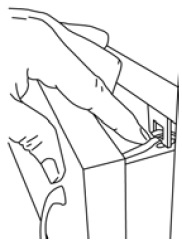
Figure 1
-
A portable locking pouch for you to keep a small supply of OTFC nearby. The rest of your OTFC must be kept in a locked storage space.
- Keep this pouch secured with its lock and keep it out of the reach and sight of children (See Figure 2).
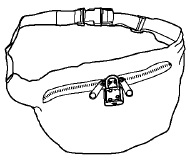
Figure 2
- A child-resistant temporary storage bottle (See Figure 3).

Figure 3
- Store OTFC at room temperature, 59°F to 86°F (15°C to 30°C) until ready to use.
- Do not freeze OTFC.
- Keep OTFC in the original sealed child-resistant blister package. Do not open the blister package until you are ready to use OTFC.
- Keep OTFC dry.
How should I dispose of Oral Transmucosal Fentanyl Citrate (OTFC) units when they are no longer needed?
Disposing of OTFC units after use:
Partially used OTFC units may contain enough medicine to be harmful or fatal to a child or other adults who have not been prescribed OTFC. You must properly dispose of the OTFC handle right away after use even if there is little or no medicine left on it.
After you have finished the OTFC unit and the medicine is totally gone, throw the handle away in a place that is out of the reach of children.
If any medicine remains on the used OTFC unit after you have finished:
- Place the used OTFC unit under hot running water until the medicine is gone, and then throw the handle away out of the reach of children and pets (See Figure 4).
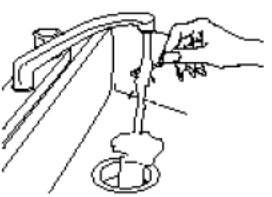
Figure 4
Temporary Storage of Used OTFC Units:
- If you did not finish the entire OTFC unit and you cannot dissolve the medicine under hot running water right away, put the used OTFC unit in the temporary storage bottle that you received in the OTFC Child Safety Kit. Push the used OTFC unit into the opening on the top until it falls completely into the bottle. Never leave unused or partially used OTFC units where children or pets can get to them (See Figure 5).
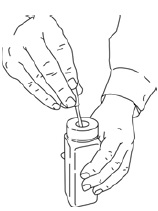
Figure 5
Disposing of Used OTFC Units from the Temporary Storage Bottle:
You must dispose of all used OTFC units in the temporary storage bottle at least one time each day, as follows:
1. To open the temporary storage bottle, push down on the cap until you are able to twist the cap to the left to remove it (See Figure 6).

Figure 6
2. Remove one OTFC unit from the temporary storage bottle. Hold the OTFC by its handle over the toilet bowl.
3. Using wire-cutting pliers, cut the medicine end off so that it falls into the toilet.
4. Throw the handle away in a place that is out of the reach of children.
5. Repeat these 3 steps for each OTFC handle that is in the storage bottle. There should not be more than 4 handles in the temporary storage bottle for 1 day.
6. Flush the toilet twice.
Do not flush entire unused OTFC units, OTFC handles, or blister packages down the toilet.
Disposing of unopened OTFC units: Dispose of any unopened OTFC units remaining from a prescription as soon as they are no longer needed, as follows:
1. Remove all OTFC from the locked storage space (See Figure 7).
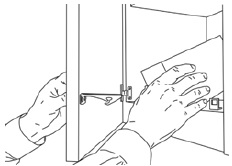
Figure 7
2. Remove one OTFC unit from its blister package by using scissors to cut off the marked end and then peel back the blister backing (See Figures 8A and 8B).

Figure 8A Figure 8B
3. Hold OTFC by its handle over the toilet bowl. Use wire-cutting pliers to cut the medicine end off so that it falls into the toilet (See Figures 9A and 9B).

Figure 9A Figure 9B
4. Throw the handle away in a place that is out of the reach of children (See Figure 10).

Figure 10
5. Repeat steps 1 through 4 for each OTFC unit.
6. Flush the toilet twice after the medicine ends from 5 OTFC units have been cut off (See Figure 11). Do not flush more than 5 OTFC units at a time.
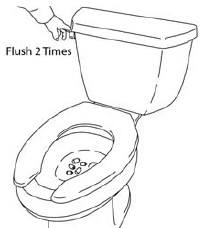
Figure 11
- Do not flush entire unused OTFC units, OTFC handles, or blister packages down the toilet.
If you need help with disposal of OTFC, call Teva Pharmaceuticals at 1-888-483-8279, or call your local Drug Enforcement Agency (DEA) office.
General information about Oral Transmucosal Fentanyl Citrate (OTFC)
Medicines are sometimes prescribed for purposes other than those listed in a Medication Guide. Use OTFC only for the purpose for which it was prescribed. Do not give OTFC to other people, even if they have the same symptoms you have. OTFC can harm other people and even cause death. Sharing OTFC is against the law.
This Medication Guide summarizes the most important information about OTFC. If you would like more information, talk with your healthcare provider or pharmacist. You can ask your pharmacist or healthcare provider for information about OTFC that is written for healthcare professionals.
For more information about the TIRF REMS Access program, go to www.TIRFREMSAccess.com or call 1-866-822-1483.
What are the ingredients of Oral Transmucosal Fentanyl Citrate (OTFC)?
Active Ingredient: fentanyl citrate
Inactive Ingredients: sugar, citric acid, dibasic sodium phosphate, artificial berry flavor, magnesium stearate, modified food starch and confectioner’s sugar.
Patient Instructions for Use
Before you use OTFC, it is important that you read the Medication Guide and these Patient Instructions for Use. Be sure that you read, understand, and follow these Patient Instructions for Use so that you use OTFC the right way. Ask your healthcare provider or pharmacist if you have any questions about the right way to use OTFC.
When you get an episode of breakthrough cancer pain, use the dose of OTFC prescribed by your healthcare provider as follows:
- You may drink some water before using OTFC but you should not drink or eat anything while using OTFC.
- Each unit of OTFC is sealed in its own blister package (See Figure 12). Do not open the blister package until you are ready to use OTFC.

Figure 12
- When you are ready to use OTFC, cut open the package using scissors. Peel back the blister backing, and remove the OTFC unit (See Figures 13A and 13B). The end of the unit printed with “FENTANYL” and the strength number of the unit (“200”, “400”, “600”, “800”, “1200”, or “1600”) is the medicine end that is to be placed in your mouth. Hold the OTFC unit by the handle (See Figure 14).

Figure 13A Figure 13B
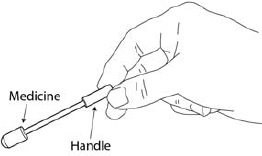
Figure 14
1. Place the medicine end of the OTFC unit in your mouth between your cheeks and gums and actively suck on the medicine.
2. Move the medicine end of the OTFC unit around in your mouth, especially along the inside of your cheeks (See Figure 15).
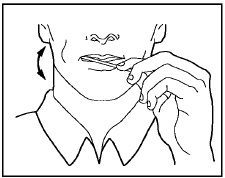
Figure 15
3. Twirl the handle often.
4. Finish the OTFC unit completely over 15 minutes to get the most relief. If you finish OTFC too quickly, you will swallow more of the medicine and get less relief.
5. Do not bite or chew OTFC. You will get less relief for your breakthrough cancer pain.
- If you cannot finish all of the medicine on the OTFC unit and cannot dissolve the medicine under hot tap water right away, immediately put the OTFC unit in the temporary storage bottle for safe keeping (See Figure 16).
- Push the OTFC unit into the opening on the top until it falls completely into the bottle. You must properly dispose of the OTFC unit as soon as you can.
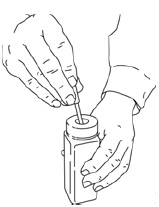
Figure 16
See “How should I dispose of Oral Transmucosal Fentanyl Citrate (OTFC) units when they are no longer needed?” for proper disposal of OTFC.
|
Distributed by: Teva Pharmaceuticals USA, Inc. call 1-888-483-8279 OTFMG-017 Printed in USA |
|
This Medication Guide has been approved by the U.S. Food and Drug Administration. Revised: 1/2024 |